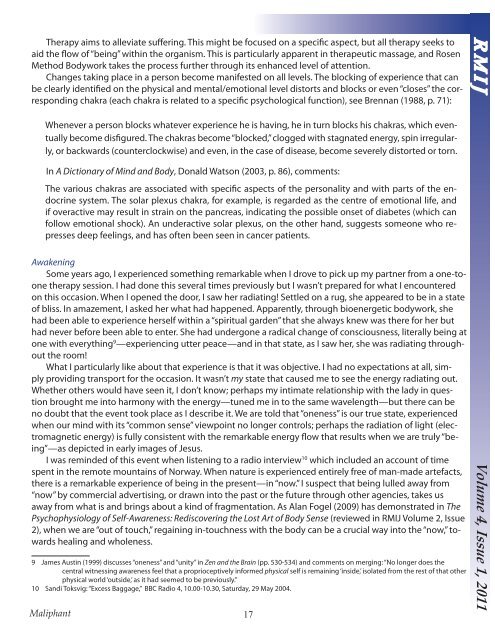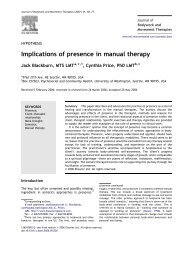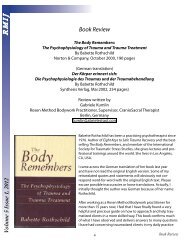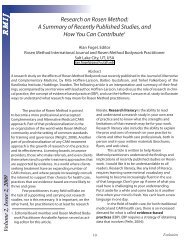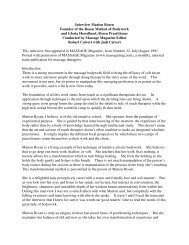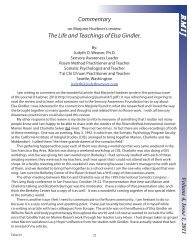R M I J ... Volume 4 Issue 1, 2011 - Rosen Journal
R M I J ... Volume 4 Issue 1, 2011 - Rosen Journal
R M I J ... Volume 4 Issue 1, 2011 - Rosen Journal
You also want an ePaper? Increase the reach of your titles
YUMPU automatically turns print PDFs into web optimized ePapers that Google loves.
Therapy aims to alleviate suffering. This might be focused on a specific aspect, but all therapy seeks to<br />
aid the flow of “being” within the organism. This is particularly apparent in therapeutic massage, and <strong>Rosen</strong><br />
Method Bodywork takes the process further through its enhanced level of attention.<br />
Changes taking place in a person become manifested on all levels. The blocking of experience that can<br />
be clearly identified on the physical and mental/emotional level distorts and blocks or even “closes” the corresponding<br />
chakra (each chakra is related to a specific psychological function), see Brennan (1988, p. 71):<br />
Whenever a person blocks whatever experience he is having, he in turn blocks his chakras, which eventually<br />
become disfigured. The chakras become “blocked,” clogged with stagnated energy, spin irregularly,<br />
or backwards (counterclockwise) and even, in the case of disease, become severely distorted or torn.<br />
In A Dictionary of Mind and Body, Donald Watson (2003, p. 86), comments:<br />
The various chakras are associated with specific aspects of the personality and with parts of the endocrine<br />
system. The solar plexus chakra, for example, is regarded as the centre of emotional life, and<br />
if overactive may result in strain on the pancreas, indicating the possible onset of diabetes (which can<br />
follow emotional shock). An underactive solar plexus, on the other hand, suggests someone who represses<br />
deep feelings, and has often been seen in cancer patients.<br />
Awakening<br />
Some years ago, I experienced something remarkable when I drove to pick up my partner from a one-toone<br />
therapy session. I had done this several times previously but I wasn’t prepared for what I encountered<br />
on this occasion. When I opened the door, I saw her radiating! Settled on a rug, she appeared to be in a state<br />
of bliss. In amazement, I asked her what had happened. Apparently, through bioenergetic bodywork, she<br />
had been able to experience herself within a “spiritual garden” that she always knew was there for her but<br />
had never before been able to enter. She had undergone a radical change of consciousness, literally being at<br />
one with everything 9 —experiencing utter peace—and in that state, as I saw her, she was radiating throughout<br />
the room!<br />
What I particularly like about that experience is that it was objective. I had no expectations at all, simply<br />
providing transport for the occasion. It wasn’t my state that caused me to see the energy radiating out.<br />
Whether others would have seen it, I don’t know; perhaps my intimate relationship with the lady in question<br />
brought me into harmony with the energy—tuned me in to the same wavelength—but there can be<br />
no doubt that the event took place as I describe it. We are told that “oneness” is our true state, experienced<br />
when our mind with its “common sense” viewpoint no longer controls; perhaps the radiation of light (electromagnetic<br />
energy) is fully consistent with the remarkable energy flow that results when we are truly “being”—as<br />
depicted in early images of Jesus.<br />
I was reminded of this event when listening to a radio interview 10 which included an account of time<br />
spent in the remote mountains of Norway. When nature is experienced entirely free of man-made artefacts,<br />
there is a remarkable experience of being in the present—in “now.” I suspect that being lulled away from<br />
“now” by commercial advertising, or drawn into the past or the future through other agencies, takes us<br />
away from what is and brings about a kind of fragmentation. As Alan Fogel (2009) has demonstrated in The<br />
Psychophysiology of Self-Awareness: Rediscovering the Lost Art of Body Sense (reviewed in RMIJ <strong>Volume</strong> 2, <strong>Issue</strong><br />
2), when we are “out of touch,” regaining in-touchness with the body can be a crucial way into the “now,” towards<br />
healing and wholeness.<br />
9 James Austin (1999) discusses “oneness” and “unity” in Zen and the Brain (pp. 530-534) and comments on merging: “No longer does the<br />
central witnessing awareness feel that a proprioceptively informed physical self is remaining ‘inside,’ isolated from the rest of that other<br />
physical world ‘outside,’ as it had seemed to be previously.”<br />
10 Sandi Toksvig: “Excess Baggage,” BBC Radio 4, 10.00-10.30, Saturday, 29 May 2004.<br />
Maliphant<br />
17<br />
R M I J<br />
<strong>Volume</strong> 4, <strong>Issue</strong> 1, <strong>2011</strong>


